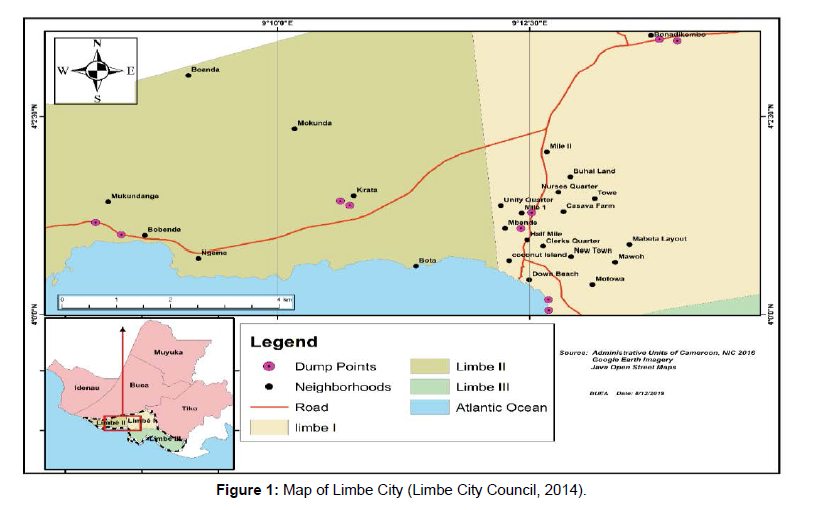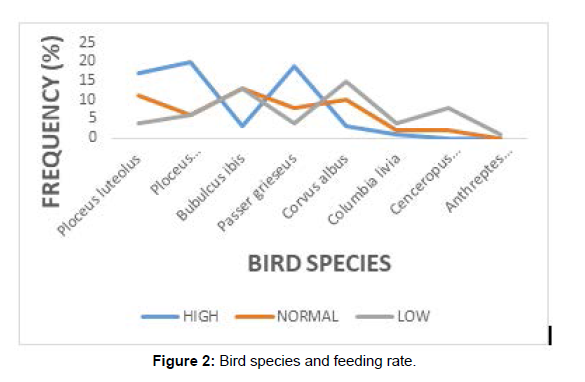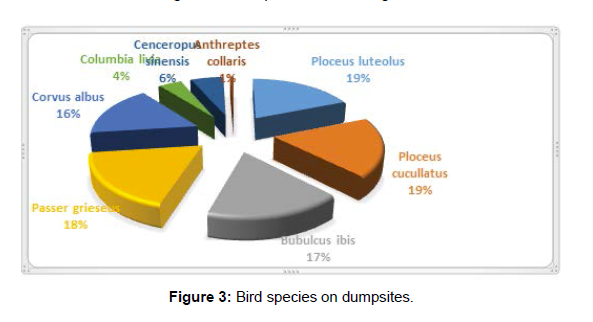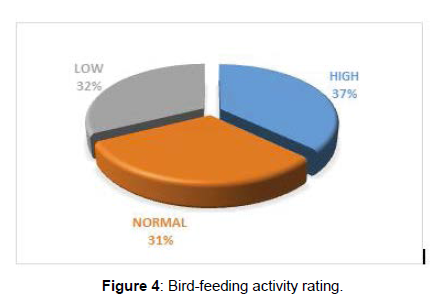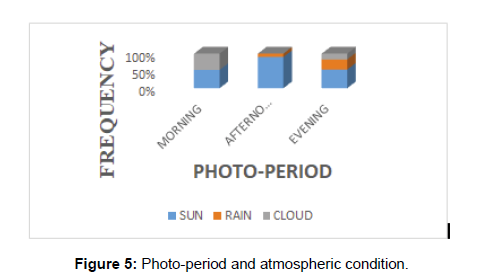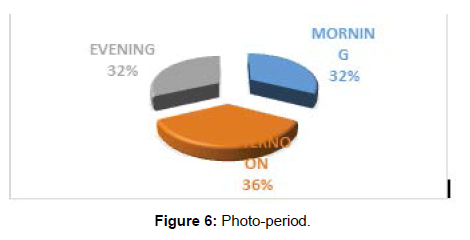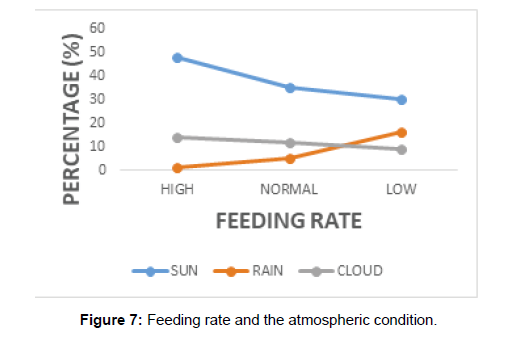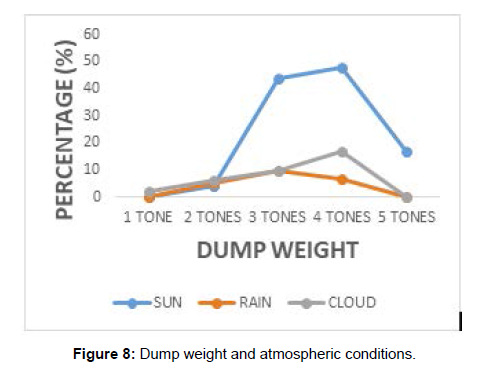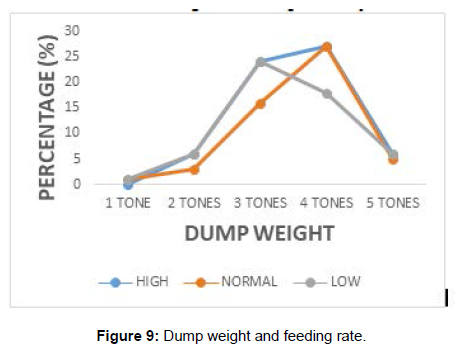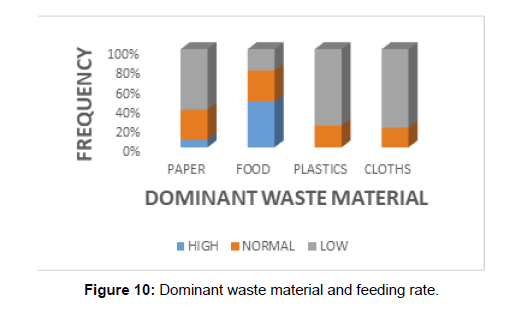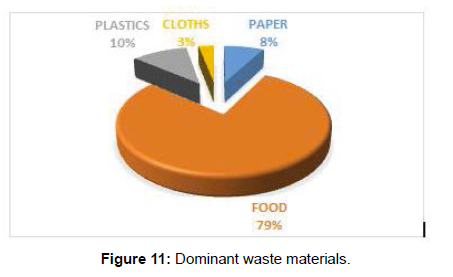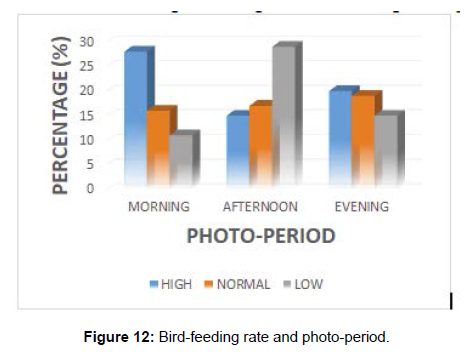Organic Waste-Dumps: A Food Subsidy to the Wild-City Birds in Limbe, Southwest Region, Cameroon
Received: 28-May-2022 / Manuscript No. EPCC-22-65268 / Editor assigned: 30-May-2022 / PreQC No. EPCC-22-65268; (PQ) / Reviewed: 14-Jun-2022 / QC No. EPCC-22-65268 / Revised: 16-Jun-2022 / Manuscript No. EPCC-22-65268 (R) / Published Date: 25-Jun-2022 DOI: 10.4172/2573-458X.1000283
Abstract
Ecological and biological processes of many bird species are regulated by human generated dump-food fragments in cities. Birds are well known to have an ecological role in both natural and modified ecosystems. The major aim of this study was to determine the ecological role of dump-food subsidy to the feeding behavior of wild-birds in Limbe city. The research area was divided into four zones, north, south, east, and west. The zonation was based on a sampling method that would reduce bias in the data collection program. Eight dumpsites were randomly selected from each zone and were visited five times a week for research data collection. On the waste-dumps, observations were done from 7:00am – 6:00pm, and the activities of all the bird species observed were recorded during the period. However, the study witnessed a significance between bird species and feeding rate X2 = 38.473 df=6, P=0.000. More so, the presence of 8-bird species was recorded on waste-dumps, amongst which was Ploceus cucullatus 19%, Ploceus luteolus 19%, Passer griseus 18%, Bubulcus ibis 17%, Corvus albus 16% were the highest while Anthreptes collaris 1%, Columbia livia 4%, Cenceropus sinensis 6% the lowest. The atmospheric condition and photo-period recorded a significance X2 = 20.597 df=4, P=0.000. The study revealed highest bird activity rate in the afternoon period of the day 36% compared to morning 32% and evening 32% each respectively. Feeding rate and atmospheric changes were significant X2 = 29.499 df=7, P=0.000. Dump-weight estimate showed a significance on atmospheric condition and feeding rate as well X2 = 5.616 df=8, P<0.05 and X2 = 57.712 df=14, P=0.000 respectively. Additionally, dominant waste material and feeding rate recorded a significance X2 = 13.269 df=4, P=0.010. The most dominant material found on all the dumps was food fragments 79% compared to plastics 10%, paper 8%, and cloths 3% respectively. There was a positive correlation between feeding rate and photo-period r = 0.205, P=.0.007. The study discovered that street-waste dumps were sometimes collected/removed by the management authorities after weeks or even months of accumulation causing windblown light fragments to litter the roads and nearby compounds. Additionally, insects, rodents, snakes, domestic animals, and birds that feed on these dumps sometimes visit human homes and may vector illnesses like, malaria, cholera, and typhoid, amongst others to humans.
Keywords
Birds; Dumpsites; Feeding rate; Atmospheric condition; Limbe city
Introduction
The world is urbanizing rapidly (United Nations, Department of Economic and Social Affairs, Population Division, 2014), as a result, human–wildlife interactions will become ever more commonplace. One of the most popular and globally common of such interactions is the feeding of wild birds in residential gardens or backyards, referred as “garden bird feeding” that is widespread across many parts of the developed world [1]. This pastime is increasingly becoming the subject of scientific and societal scrutiny (Robb et al., 2008a). Bird feeding on waste dumps has been advocated as an essential conservation activity, a simple way for people to connect with nature in an urbanizing world, and a means for enhancing environmental awareness and psychological wellbeing [2,3]. However, it has also been implicated in the spread of catastrophic avian diseases [4,5], altering ecosystem structure, benefiting invasive species [6], changing predator-prey dynamics [7], and even contributing to rapid evolutionary change [8].
Furthermore, the possibility that birds may become dependent on anthropogenic food is a primary concern of both opponents to, and proponents of bird feeding [9,10]. These issues constitute a far from exhaustive list and clearly a more complete understanding of this interaction between birds and humans should be a significant research priority. This is especially pertinent within the context of urban ecology [11] as it is becoming clear that many animal and plant populations exhibit “phenotypic signatures” associated with the urban areas in which they live [12]. Bird feeding has previously been described as a supplementary feeding experiment on a global scale but without due consideration of its effects on the behavioral, community, and population ecology of the birds consuming supplements [13]. However, despite the above concerns, scientific investigations into most aspects of the practice are fragmentary and geographically limited.
The scale of bird feeding by a range of different criteria is remarkable. In the United Kingdom (UK), various studies have found that more than 60% of households regularly feed birds in their gardens, spending US$188–226 million on 60,000 tons of birdseed annually [14]. Robb et al. (2008a) estimated that sufficient seed was distributed for blue tits (Cyanistes caeruleus) alone to support five times the national population of the species. In the United States (US), the 2011 National Survey of Fishing, Hunting, and Wildlife-Associated Recreation reported that 52.8 million households practiced some form of bird-feeding, giving a countrywide rate of 73% (U.S. Fish Wildlife Service and U.S. Census Bureau, 2011) spending a total of US$4 billion on birdseed and an additional US$10 billion on related hardware and peripherals, annually.
The annual amount of bird food supplied in the US is ∼500,000 tons, enough to feed 300 million chickadees (Poecile spp), if they consumed nothing else. Although bird-feeding is commonly practiced through much of North America and parts of Europe, relatively little is known about its extent and scale in countries other than Germany, Norway, Sweden, the UK, and the US [15]. Anecdotally, there has long been a general impression that it is a far more established practice in the more northern European countries, a conclusion confirmed by a recent informal qualitative survey. The widespread practice of wildbird feeding is directly linked to geographical areas that experience prolonged or extreme climatic conditions during winter. Indeed, apart from the notable exceptions of the UK and Germany, wild-bird feeding in northern Europe remains almost entirely a winter-only activity. In contrast, bird feeding is rarely practiced throughout the countries of southern Europe, although there are some enclaves—notably areas with residents from more northern European countries—where some wild-bird feeding does occur.
Materials and methods
Description of the study area
Limbe city is found in southwest region of Cameroon, with an estimated population of 118,470 inhabitants, it is located between longitude 9º E, and latitude 4º N. Climatically, Limbe is dominated by equatorial climate of high rainfall and high temperature. Average monthly temperatures are like any other part of the region, with the hottest month recording a monthly temperature of 33ºC (February- March) and the coldest months recording as low as 23ºC (June– October) (Limbe City Council 2014). Two major seasons exist in the area, the rainy and the dry seasons. In the past, the rainy season occurred from March, extending to October and the dry season from November to February each year. But due to the present climatic change problem, the rainy season extends up to October and December. The primary and secondary forests are rich in flora species in the municipality. However, over 80% of the primary forest had long been exploited by timber companies (Figure 1).
Methods of data collectionThe field research started with a pilot study to test the methods to be used in the process. The exercise witnessed adjustment of some variables in the check-sheet not possible for data collection. Hence, the data collection program started in the month of March and ended in July. The research area was divided into four zones, north, south, east, and west zone. The zonation was based on a sampling method that would reduce bias in the data collection program. Also, eight dumpsites were randomly selected from each zone and were visited five times a week for research data collection. On the dumps, observations were done from 7:00am – 6:00pm, and the activities of all the bird species observed were recorded during the period [16]. Moreover, the ecological conditions like atmospheric changes, photo-period, the weight estimate of dumps, proximity of dump to residential homes, major dump materials were recorded simultaneously.
Research data analysis
The data was analyzed by using chi-square (X2) and correlation (r) statistical models. The inferential and exploratory statistics helped to examine the variables against each other, and to understand their degree of association. The bird species and their activities were examined on dump weight, dump proximity to human residence, and the atmospheric changes.
Results
The study revealed a significance between bird species and their feeding rate X2 = 38.473 df=6, P=0.000 (Figure 2). Limbe city is found at the foot of mount Cameroon, with a fertile volcanic soil and petroleum refinery, it has attracted a hug human population from all parts of the country generating social activities. Waste generation in
cities increases proportionately with human population activities, as a result, bird population that depend on these waste materials for feeding also increases in most communities. The city of Limbe is witnessing an unprecedented increase in bird species and population because of the hug concentration of solid waste materials, a permanent food subsidy to the birds. This study recorded the presence of 8 birds on dumpsites, amongst which were Ploceus cucullatus 19%, Ploceus luteolus 19%, Passer griseus 18%, Bubulcus ibis 17%, and Corvus albus 16% as the highest while Anthreptes collaris 1%, Columbia livia 4%, Cenceropus sinensis 6% the lowest (Figure 3). There was a high-feeding-bird activity on waste-dumps 37% compared to low 32% and normal 31% respectively (Figure 4).Also, the atmospheric condition and photo-period recorded a significance X2 = 20.597 df=4, P=0.000 (Figure 5). The study revealed
the highest bird activity rate in the afternoon period of the day 36% compared to morning 32%, and evening 32% each respectively (Figure 6). Most studies carried out on wildlife ecological often witness a high activity rate during the morning period of the day. However, most cities in Cameroon have high social activity during the morning period of the day, low in the afternoon probably due to tiredness, with a gradual increase in the evening periods when people must have recovered little from mid-day-activity exhaustion. Wild-city birds in Cameroon are scared of human presence at proximity; hence, their high feeding rate at dumpsites could be favored by a reduced human-activity presence in the afternoon period. The study also discovered waste-dumps that were further from human presence had more birds’ activity than the rest. Feeding rate and atmospheric changes were significant X2 = 29.499 df=7, P=0.000 (Figure 7). Atmospheric changes have been among the key factors influencing wildlife activities, especially feeding activity. A poor atmospheric condition could reduce or stop feeding completely– heavy rainfall and snow storms in most parts of the world have affected wildlife feeding considerably. The sunny atmosphere was a favorite atmospheric condition for bird-feeding activity at the dumpsites. On the other hand, a dry sunny atmospheric condition was wind-blowing light solid-waste materials into the roads, residential homes, and other unexpected areas further from dumpsites. Additionally, a bright sunny atmosphere would attract insects such as flies that could vector human diseases like malaria.Dump weight recorded a significance on atmospheric conditions and feeding rate X2 = 5.616 df=8, P<0.05 (Figure 8) and X2 = 57.712
df=14, P=0.000 respectively (Figure 9). Solid-waste dumping depends on the human population and their waste generating activities. Limbe city has solid-waste-disposal sites along the streets, unfortunately, frequent waste collection is carried out only on the roadside dumps except for those behind residential homes, restaurants, business shops, and offices due to lack of accessibility. Sometimes, the management of unofficial waste-dumps is done by incineration especially during the dry season when the waste must have lost enough moisture content to permit easy incineration. Nevertheless, the incineration method of the solid-waste management in this city means waste would accumulate for probably up to one year for the dry season to exhaust the moisture content. This long-wait, ends up increasing the dump-volume, and consequently, an increase in bird population depending on this food survival. The survey also revealed that larger dumps received more bird-feeding activities because of their richness in in food fragments comparatively.Dominant waste material and feeding rate recorded a significance as well X2 = 13.269 df=4, P=0.010 (Figure 10). The most dominant
material found on all the dumpsites was food fragments 79% compared to plastics 10%, papers 8%, and cloths 3% respectively (Figure 11). Food fragments at dumpsites from the hug human population in this city cannot be easily incinerated compared to other solid-waste fragments.There was a positive correlation between feeding rate and photoperiod r = 0.205, P=.0.007 (Figure 12). Wildlife-feeding-activity rate
is influenced by the day-period, as proven by this study. The highest feeding activity was during the morning period of the day, followed by afternoon, and then the evening, reflecting a normal feeding-activity pattern of wild-city birds.Discussion
The importance of food resources in all aspects of the lives of animals is fundamental to understanding population and community dynamics. These complex interactions have been investigated experimentally in a vast number of supplementary feeding studies on many different species and in many biomes. However, remarkably little empirical data exist for comparison between cities and species. In part, this is due to the many challenges associated with undertaking scientifically robust studies in environments unavoidably occupied by high densities of people. Nonetheless, a growing number of important pioneering investigations are shedding light on the ecological influence of food supplements on the local community of birds.
One recent study compared the changes in composition and abundance of the suburban bird community in Auckland, New Zealand over an 18-month period during which food was provided by householders, followed by its withdrawal [17]. The results were dramatic for several of the species involved, with increased abundance of house sparrows and spotted doves (Streptopelia chinensis)—both introduced species—during the provisioning phase, while that of the native gray gerygone (Gerygone igata) was significantly lower. The influence of feeding in shaping avian communities was further emphasized when the community returned to its pre-supplementary feeding structure within only a few weeks of the cessation of feeding. An important (but rarely achieved) aspect of this study was the willing compliance of the participants to engage with the scientific objectives in stopping feeding birds when instructed to do so to allow the role of feeding to be investigated rigorously.
In the UK, bird-feeding in cities results in peaks in numbers of farmland bird species such as the yellow hammer (Emberiza citronella) in the late spring in response to food deficits on farmland caused by changes in agricultural practice such as the loss of winter stubbles [18]. Such transient incursions into urban areas from surrounding countryside typically result in temporary changes to urban bird community structure. In contrast, changes in migration patterns of some species such as the Eurasian blackcap have led to more enduring changes to community structure because birds are now present throughout the winter in the UK. This is a trend that has grown in blackcaps in the last 60 years and appears to be closely related to the increased availability of feeders in gardens [19].
It is expected that urban bird communities will continue to be sensitive to anthropogenic feeding practices resulting in foods being available year-round. This will increase the carrying capacity of urban habitats despite also potentially increasing the creation of many more ecological/evolutionary traps and sink habitats [20,21]. As well as changes in short-distance movements and seasonal migratory patterns of native species, bird-feeding in urban centers has also favored the predominance of introduced species in New Zealand. Galbraith et al. (2015) found greater abundances of introduced house sparrows and spotted doves at feeders in Auckland and reduced abundances of native species such as gray gerygones. While feeders clearly attract greater numbers of the species using them, they may also reduce species richness in the avian community because of the predominance of introduced species. Certainly, in the UK and the rest of temperate Europe the introduced rose-ringed parakeet (Psittacula krameri) has established in many cities with its success at least in part associated with access to urban bird feeders [22,23]. This species not only out competes many native species for food but also for nest sites [24,25].
Perhaps the most concerning impact of bird feeding is its potential to spread disease. Although there is often strong defense of feeding in response to this concern, numerous studies have strongly implicated feeders as mediating infection and exacerbating the virulence of outspread, most markedly in the case of house finch mycoplasma Hartup and trichomoniasis [26]. The implications of this potential link between likelihood of epidemics and bird feeders are sufficiently significant to warrant a high level of concern and action among all people engaged in the pastime. The response may be as simple as regular hygienic practices [27]. However, the best such approaches are not “second nature” to the bird feeding public, and thus much remains to be developed both in terms of adding to knowledge and effective communication of pertinent research outputs to the “end user” [28].
Conclusion
Wildlife population in cities, especially birds predominantly depend on solid waste dumps for feeding. This is because urban development is destructive to wildlife habitats that homes many wildlife species, hence, wildlife population decline in sub Saharan Africa has been based on this problem. Limbe is a coastline city at the foot of mount Cameroon known to be rich in wild-bird species, however, the increased human population and its activity has established an ecological zone beneficial to the wild-bird population through the solid-waste dumps. Solid-waste management in some communities in Cameroon is facing challenges, poorly trained personnel, low salary of workers, and segregation of waste fragments. The street-waste dumps are sometimes collected/ removed by the management authorities after weeks or even months of accumulation causing windblown light fragments into the roads and nearby compounds. Additionally, insects, rodents, snakes, domestic animals, and birds that feed on these waste-dumps visit human homes and may vector illnesses such as malaria, cholera, and typhoid, amongst many others.
References
- Alberti M, Correa C, Marzluff JM, Hendry AP, Palkovacs EP, et al. (2017) Global urban signatures of phenotypic change in animal and plant populations. Proc Natl Acad Sci 114: 8951-8956.
- Bearhop S, Fiedler W, Furness RW, Votier SC, Waldron S, et al. (2005) Assortative mating as a mechanism for rapid evolution of a migratory divide. Science 310: 502-504.
- Chamberlain DE, Vickery JA, Glue DE, Robinson RA, Conway GJ, et al. (2005) Annual and seasonal trends in the use of garden feeders by birds in winter. Ibis 147: 563-575.
- Cleary GO, Coleman BR, Davis AD, Jones DN, Miller KK, et al. (2016) Keeping it clean: bird bath hygeine in urban and rural areas. J Urban Ecol 2: 1-4.
- Clergeau P, Vergnes A (2011) Bird feeders may sustain feral rose-ringed parakeets Psittacula krameri in temperate Europe. Wildl Biol 17: 248-252.
- Cox DT, Gaston KJ (2015) Likeability of garden birds: importance of species knowledge & richness in connecting people to nature. PLoS ONE 10: e0141505.
- Cox DT, Gaston KJ (2016) Urban bird feeding: connecting people with nature. PLoS ONE 11: e0158717.
- Davies ZG, Fuller RA, Dallimer M, Loram A, Gaston KJ (2012) Household factors influencing participation in bird feeding activity: a national scale analysis. PLoS ONE 7: e39692.
- Dhondt AA, Dhondt KV, Hawley DM, Jennelle CS (2007) Experimental evidence for transmission of Mycoplasma gallisepticum in house finches by fomites. Avian Pathol 36: 205-208.
- Fuller RA, Warren PH, Armsworth PR, Barbosa R, Gaston KJ (2008) Garden bird feeding predicts the structure of urban avian assemblages. Diversity Distrib 14: 131-137.
- Galbraith JA, Beggs JR, Jones DN, McNaughton EJ., Krull CR, et al. (2014) Risks and drivers of wild bird feeding in urban areas of New Zealand. Biol Conserv 180: 64-74.
- Galbraith JA, Beggs JR, Jones DN, Stanley MC (2015) Supplementary feeding restructures urban bird communities. Proc Natl Acad Sci 112: 1-10.
- Hartup BK, Bickal JM, Dhondt AA, Ley DH, Kollias GV (2001) Dynamics of conjunctivitis and Mycoplasma gallisepticum infections in house finches. Auk 118: 327-333.
- Howard P, Jones DN (2004) A qualitative study of wildlife feeding in south-east Queensland. Urban Wildlife: More than Meets the Eye, eds D. Lunney and S. Burgin 55-62.
- Jones D (2011) An appetite for connection: Why we need to understand the effect and value of feeding wild birds. Emu 111: 1-7.
- Jones DN (2017) Influential factors for natal dispersal in an avian island metapopulation. J Avian Biol 39: 265-271.
- Jones DN, Reynolds SJ (2008) Feeding birds in our towns and cities: a global 966 research opportunity. J Avian Biol 39: 265-271.
- Lawson B, Robinson RA, Colvile KM, Peck KM, Chantrey J, et al. (2012) The emergence and spread of finch trichomonosis in the British Isles. Phil Trans R Soc B 367: 2852-2863.
- Leston LF, Rodewald AD (2006) Are urban forests ecological traps for understory birds? An examination using Northern Cardinals. Biol Conserv 131: 566-574.
- Limbe City Council (2014) The Limbe City Council Report.
- Malpass JS, Rodewald AD, Matthews SN (2017) Species dependent effects of bird feeders on nest predators and nest survival of urban American Robins and Northern Cardinals. Condor 119: 1-16.
- Plummer KE, Siriwardena GM, Conway GJ, Risely K, Toms MP (2015) Is supplementary feeding in gardens a driver of evolutionary change in a migratory bird species? Glob Change Biol 21: 4353-4363.
- Robb GN, McDonald RA, Chamberlain DE, Bearhop S (2008) Food for thought: supplementary feeding as a driver of ecological change in avian populations. Front Ecol Environ 6: 476-484.
- Robinson RA, Lawson B, Toms MP, Peck KM, Kirkwood JK, et al. (2010) Emerging infectious disease leads to rapid population declines of common British birds. PLoS ONE 5: e12215.
- Sidra S, Ali Z, Chaudhry NM (2013) Avian diversity at new campus of Punjab University in relation to land use change. Pakis J Zool 45: 1069-1082.
- Strubbe D, Matthysen E (2009) Experimental evidence for nest-site competition between invasive ring-necked parakeets (Psittacula krameri) and native nuthatches (Sitta europaea). Biol Conserv 142:1588-1594.
- United Nations, World Urbanization Prospects: The 2014 Revision, Highlights (ST/ESA/SER.A/352). New York, NY: The United Nations.
- U.S. Fish and Wildlife Service and U.S. Census Bureau (2011) National Survey of Fishing, Hunting, and Wildlife-Associated Recreation.
Indexed at, Google Scholar, Crossref
Indexed at, Google Scholar, Crossref
Indexed at, Google Scholar, Crossref
Indexed at, Google Scholar, Crossref
Indexed at, Google Scholar, Crossref
Indexed at, Google Scholar, Crossref
Indexed at, Google Scholar, Crossref
Indexed at, Google Scholar, Crossref
Indexed at, Google Scholar, Crossref
Indexed at, Google Scholar, Crossref
Citation: Maurice ME, Blessing NT, Veronique M, Ebong EL, Moumine NA, et al. (2022) Organic Waste-Dumps: A Food Subsidy to the Wild-City Birds in Limbe, Southwest Region, Cameroon. Environ Pollut Climate Change 6: 283. DOI: 10.4172/2573-458X.1000283
Copyright: © 2022 Maurice ME, et al. This is an open-access article distributed under the terms of the Creative Commons Attribution License, which permits unrestricted use, distribution, and reproduction in any medium, provided the original author and source are credited.
Select your language of interest to view the total content in your interested language
Share This Article
Recommended Journals
Open Access Journals
Article Tools
Article Usage
- Total views: 2773
- [From(publication date): 0-2022 - Nov 19, 2025]
- Breakdown by view type
- HTML page views: 2208
- PDF downloads: 565

